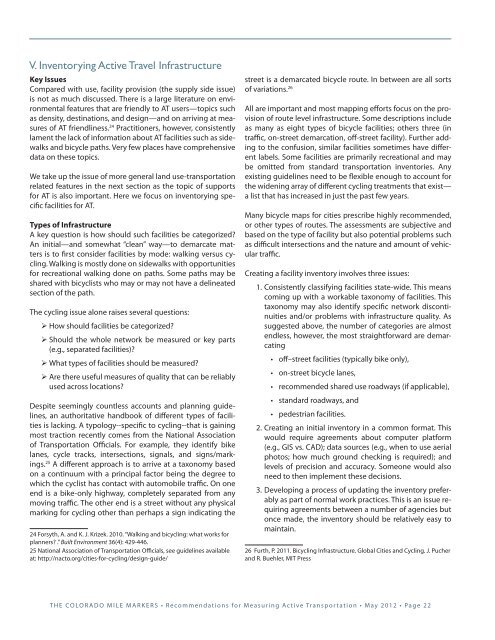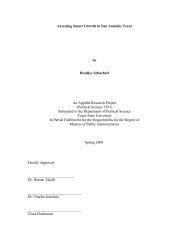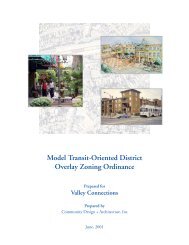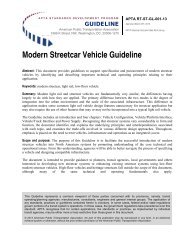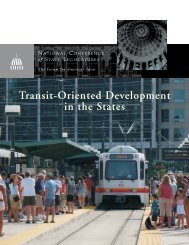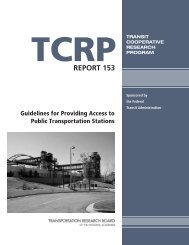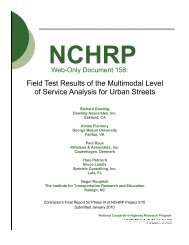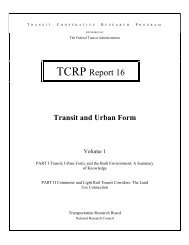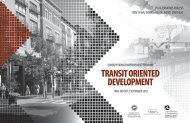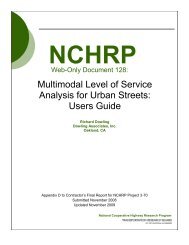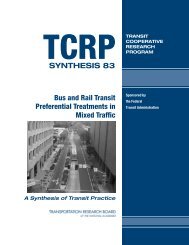the colorado mile markers: recommendations for measuring ...
the colorado mile markers: recommendations for measuring ...
the colorado mile markers: recommendations for measuring ...
You also want an ePaper? Increase the reach of your titles
YUMPU automatically turns print PDFs into web optimized ePapers that Google loves.
V. Inventorying Active Travel Infrastructure<br />
Key Issues<br />
Compared with use, facility provision (<strong>the</strong> supply side issue)<br />
is not as much discussed. There is a large literature on environmental<br />
features that are friendly to AT users—topics such<br />
as density, destinations, and design—and on arriving at measures<br />
of AT friendliness. 24 Practitioners, however, consistently<br />
lament <strong>the</strong> lack of in<strong>for</strong>mation about AT facilities such as sidewalks<br />
and bicycle paths. Very few places have comprehensive<br />
data on <strong>the</strong>se topics.<br />
We take up <strong>the</strong> issue of more general land use-transportation<br />
related features in <strong>the</strong> next section as <strong>the</strong> topic of supports<br />
<strong>for</strong> AT is also important. Here we focus on inventorying specific<br />
facilities <strong>for</strong> AT.<br />
Types of Infrastructure<br />
A key question is how should such facilities be categorized<br />
An initial—and somewhat “clean” way—to demarcate matters<br />
is to first consider facilities by mode: walking versus cycling.<br />
Walking is mostly done on sidewalks with opportunities<br />
<strong>for</strong> recreational walking done on paths. Some paths may be<br />
shared with bicyclists who may or may not have a delineated<br />
section of <strong>the</strong> path.<br />
The cycling issue alone raises several questions:<br />
‣ ¾How should facilities be categorized<br />
‣ ¾should <strong>the</strong> whole network be measured or key parts<br />
(e.g., separated facilities)<br />
‣ ¾What types of facilities should be measured<br />
‣ ¾Are <strong>the</strong>re useful measures of quality that can be reliably<br />
used across locations<br />
Despite seemingly countless accounts and planning guidelines,<br />
an authoritative handbook of different types of facilities<br />
is lacking. A typology--specific to cycling--that is gaining<br />
most traction recently comes from <strong>the</strong> National Association<br />
of Transportation Officials. For example, <strong>the</strong>y identify bike<br />
lanes, cycle tracks, intersections, signals, and signs/markings.<br />
25 A different approach is to arrive at a taxonomy based<br />
on a continuum with a principal factor being <strong>the</strong> degree to<br />
which <strong>the</strong> cyclist has contact with automobile traffic. On one<br />
end is a bike-only highway, completely separated from any<br />
moving traffic. The o<strong>the</strong>r end is a street without any physical<br />
marking <strong>for</strong> cycling o<strong>the</strong>r than perhaps a sign indicating <strong>the</strong><br />
24 Forsyth, A. and K. J. Krizek. 2010. “Walking and bicycling: what works <strong>for</strong><br />
planners .” Built Environment 36(4): 429-446.<br />
25 National Association of Transportation Officials, see guidelines available<br />
at: http://nacto.org/cities-<strong>for</strong>-cycling/design-guide/<br />
street is a demarcated bicycle route. In between are all sorts<br />
of variations. 26<br />
All are important and most mapping ef<strong>for</strong>ts focus on <strong>the</strong> provision<br />
of route level infrastructure. Some descriptions include<br />
as many as eight types of bicycle facilities; o<strong>the</strong>rs three (in<br />
traffic, on-street demarcation, off-street facility). Fur<strong>the</strong>r adding<br />
to <strong>the</strong> confusion, similar facilities sometimes have different<br />
labels. Some facilities are primarily recreational and may<br />
be omitted from standard transportation inventories. Any<br />
existing guidelines need to be flexible enough to account <strong>for</strong><br />
<strong>the</strong> widening array of different cycling treatments that exist—<br />
a list that has increased in just <strong>the</strong> past few years.<br />
Many bicycle maps <strong>for</strong> cities prescribe highly recommended,<br />
or o<strong>the</strong>r types of routes. The assessments are subjective and<br />
based on <strong>the</strong> type of facility but also potential problems such<br />
as difficult intersections and <strong>the</strong> nature and amount of vehicular<br />
traffic.<br />
Creating a facility inventory involves three issues:<br />
1. Consistently classifying facilities state-wide. This means<br />
coming up with a workable taxonomy of facilities. This<br />
taxonomy may also identify specific network discontinuities<br />
and/or problems with infrastructure quality. As<br />
suggested above, <strong>the</strong> number of categories are almost<br />
endless, however, <strong>the</strong> most straight<strong>for</strong>ward are demarcating<br />
• off–street facilities (typically bike only),<br />
• on-street bicycle lanes,<br />
• recommended shared use roadways (if applicable),<br />
• standard roadways, and<br />
• pedestrian facilities.<br />
2. Creating an initial inventory in a common <strong>for</strong>mat. This<br />
would require agreements about computer plat<strong>for</strong>m<br />
(e.g., GIS vs. CAD); data sources (e.g., when to use aerial<br />
photos; how much ground checking is required); and<br />
levels of precision and accuracy. Someone would also<br />
need to <strong>the</strong>n implement <strong>the</strong>se decisions.<br />
3. Developing a process of updating <strong>the</strong> inventory preferably<br />
as part of normal work practices. This is an issue requiring<br />
agreements between a number of agencies but<br />
once made, <strong>the</strong> inventory should be relatively easy to<br />
maintain.<br />
26 Furth, P. 2011. Bicycling Infrastructure. Global Cities and Cycling. J. Pucher<br />
and R. Buehler, MIT Press<br />
The Colorado Mile Markers • Recommendations <strong>for</strong> Measuring Active Transportation • May 2012 • Page 22


